- A dimension is a grouping in your query (date, location, type, etc).
- A measure is an aggregation over your dimensions (sum, count, average, etc). For example, to query total revenue per day you would select a date dimension (
order_items.created_date) and a revenue measure (order_items.sum_revenue).
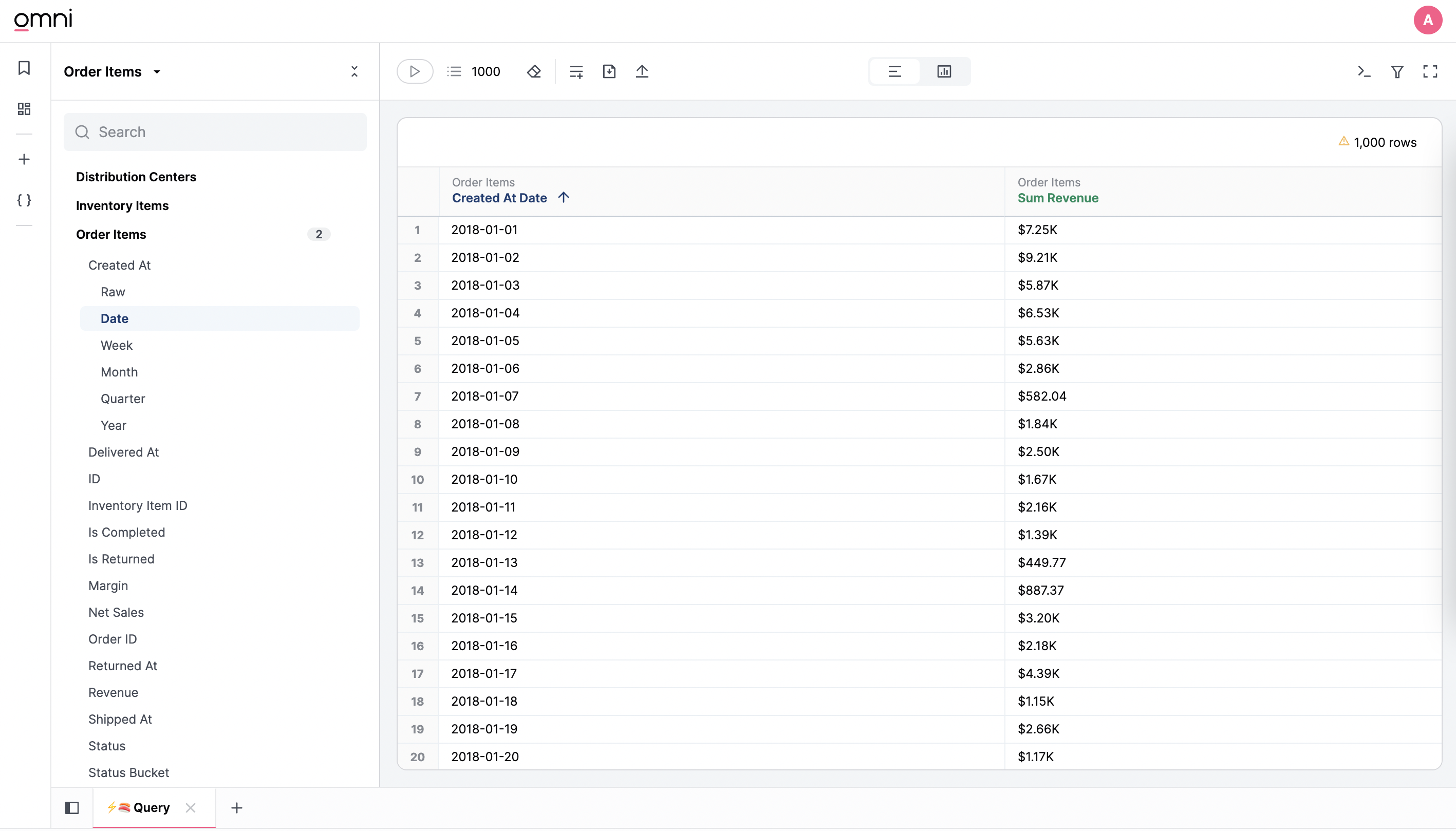
Searching fields
Fields can be searched with the input box above the field picker. Default search will hit fields and views. However, you can specify additional conditions using these filter options:- In-use - Limits results to fields in use in the query
- Field type - Limits the results to selected data types, such as
boolean,number, etc.) - Topic - Limits the results to fields in selected topics
- Label - Limits results to fields with or without labels
- Descriptions - Limits results to fields with or without descriptions
Additional operators
The search box also supports operators that allow for additional querying options. For example, to limit the field type todate fields, you’d enter data_type:date.
| Operator | Description | Example |
|---|---|---|
| data_type: | Filters fields based on data type: date, string, boolean, interval, array, json, number | data_type:date |
| is: | Filters fields based on whether the field is a dimension, measure, or hidden | is:dimension |
| model_type: | Filters fields based on the model type: schema, shared, branch, workbook, query | model_type:schema |
| schema: | Filters fields based the schema that contains them | schema:marketing |
| tag: | Filters fields based on the provided tag | tag:secure |
Filtering
Each dimension can be added as a filter to focus on specific rows of data. Different filtering options will be presented for dates, numbers, and strings: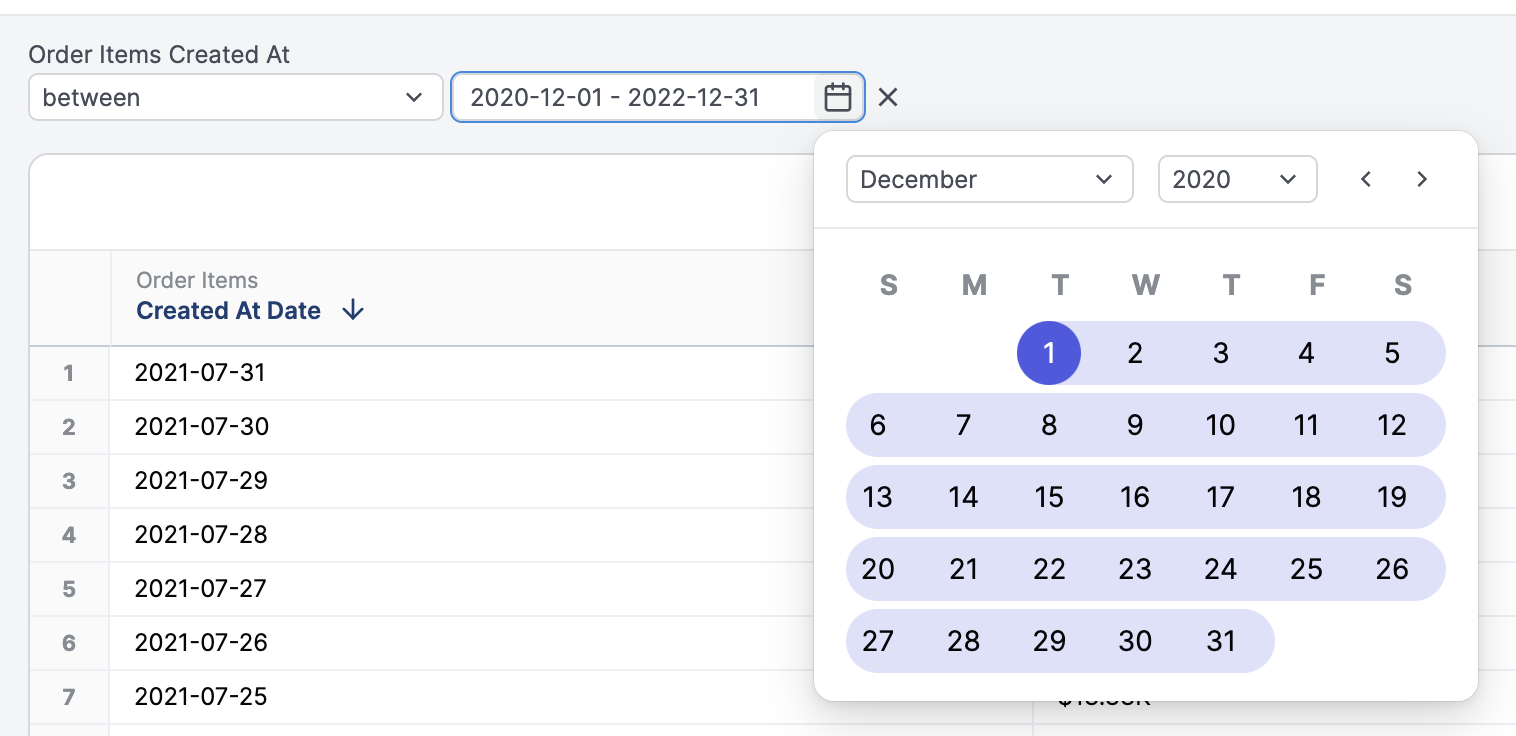

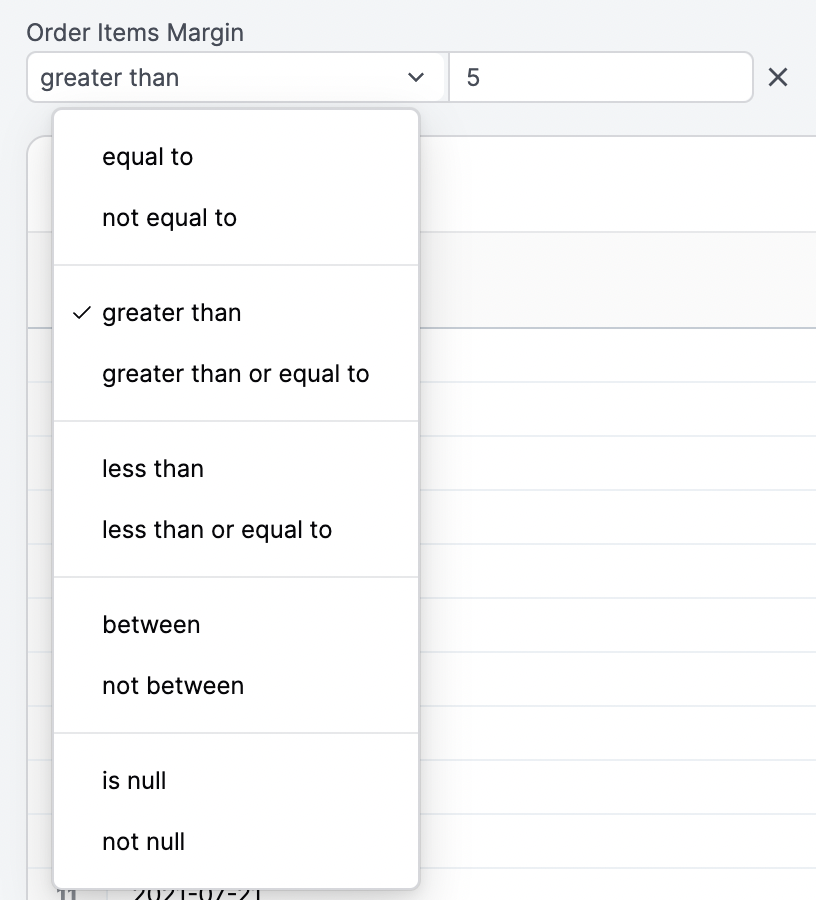
OR), insert a comma between values: [bread, cheese]. If your filter values include commas, you can escape them with \: San Francisco\, CA.
Date filters
Filter suggestions are limited to 2,000 rows.
- Absolute date filtering, such as
2022,2023-01-01,2021-Q4 - Relative date filtering, such as
after 7 complete days ago,1 year ago
first ten days of 2023 or 100 days ago for 10 days. For these situations, time for an interval duration offers more flexible time inputs:
- The first input should contain the starting point. This value should either be a date (
2023-01-01) or a relative date (10 days ago). Note:Agois required. - The second input should contain the duration.
Interval timeframe units
Intervals can accept any timeframe unit:| Interval type | Supported units |
|---|---|
| day | day, days, complete day, complete days |
| week | week, weeks, complete week, complete weeks |
| month | month, months, complete month, complete months |
| quarter | quarter, quarters, complete quarter, complete quarters |
| year | year, years, complete year, complete years |
| millisecond | millisecond, milliseconds, complete millisecond, complete milliseconds |
| second | second, seconds, complete second, complete seconds |
| minute | minutes, complete minute, complete minutes |
| hour | hour, hours, complete hour, complete hours |
Advanced filtering options
Filtering by another query
With two or more tabs, one tab, or query, can be used as a filter in other queries. This is particularly useful for creating a dynamic subset of information in one query and a deep dive into the results on another tab. For example, you want to understand the brands your top customers are purchasing. To do this, you would:- In a workbook, create a tab with the definition of a top customer.
- Create a new tab.
- In the new tab, add the dimensions and measures you want to analyze.
- In the field picker, locate a dimension used in the top customer definition tab.
- On the dimension, click the options menu (three dots) and select Filter.
- Select Is from another query.
-
In the modal that displays, select the tab and dimension you want to filter by:
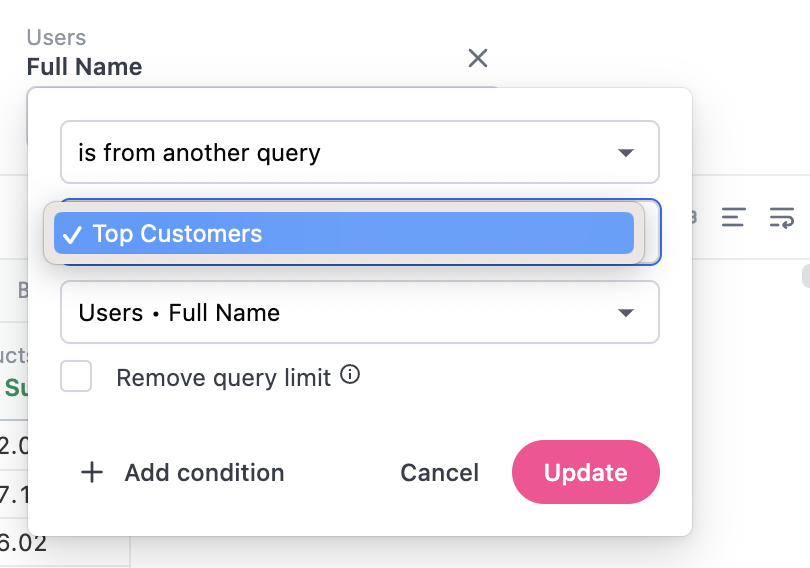
WHERE clauses that look like WHERE IN (SELECT...) where the SELECT clause is the filtering query.
You can also use this approach to filter out data. To do this, select Is not from another query in the Filter menu or the
field_name_not_in_query filter parameter.Filtering by multiple conditions
You can filter a field by multiple conditions (e.g.Date is in the past 30 days OR date is null) by clicking Add Condition in the filter modal. Then, select if you want All or Any of the conditions to apply to the query.
Filter Suggestions
Filter suggestions are populated by running a sql query to return unique values for the field being filtered on, in the context of the Topic it is in, with the exception being if any of the following parameters are in use: suggest_from, suggest_from_topic, or suggestion_list. The general format is:Refreshing filter suggestions
In rare circumstances, filter suggestions may be cached in a stale state. To enable the refresh option:- Mac - Hold
Command + Shift - Windows - Hold
Windows + Shift
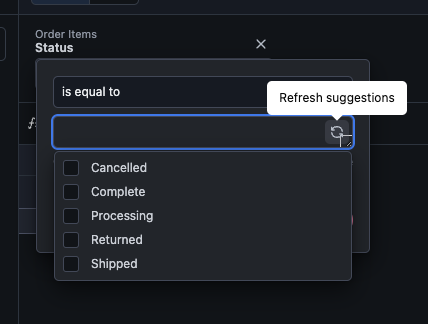
Pivoting
Quickly build pivot tables by right-clicking any field in the field picker and selecting the Pivot option.Flattening and filtered measures
You can also flatten the pivot and create filtered measures by clicking the actions menu (three dots) on a column and selecting Flatten pivot. When using this feature you can also choose to create an Other bucket on the fly: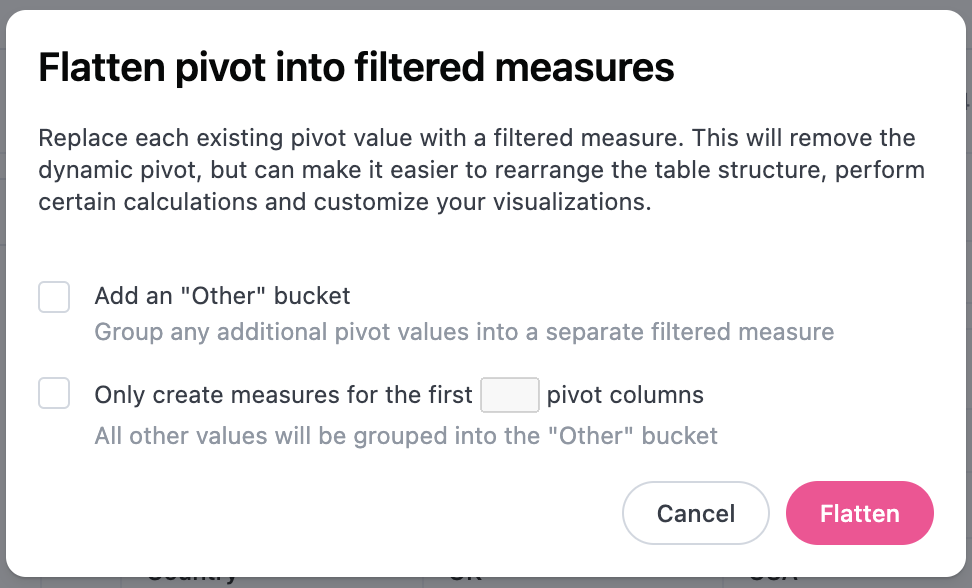
Creating custom fields
Custom fields can be created through the right click menu or using the + button in the field picker. Refer to the Custom fields guide for more information.Applying quick aggregates and timeframes
Omni provides a number of aggregations you can apply to fields right from the UI. In the field picker, right click on a field and select Aggregates. Date fields will have an additional Timeframes option.| Field type | Dimensions (Timeframes) | Measures (Aggregates) |
|---|---|---|
| Dates |
|
|
| Strings | None |
|
| Numbers | None |
|
Modeling options
In addition to the above, there are several more menu actions:- Go to definition - Opens the field definition in the model IDE
- Hide - Removes the field from the field picker; used for field cleanup
- Primary Key - Sets the field as the primary key for the view; used in counts through joined tables
Limiting and paginating rows in results
By default, queries will are filtered to 1000 rows of data, but the limit can be adjusted dynamically up to 50,000 rows and paginated to see all result rows directly in Omni. Row limits don’t impact the rows processed, only the rows available in the Omni UI. This setting is also used to paginate the results table. For example, if set to5, the results table will display five rows at a time.
Use caution with high row limits. Browsers may have limitations on the amount of data that can be shown at once.
Column and pivot limits
Omni currently supports any number of measures in the results table. Pivots are limited to 200 columns.Sorting
Data in the results table can be sorted on a column by column basis, with a cycle through descending, ascending, and unsorted. For sorting over more than one field (secondary sort or double sort), simply sort the first field and hold down shift for subsequent sort actions.Results table options
Clicking the Options button while viewing a workbook’s results allows you to a number of things:- Column Width - Allows you to automatically or manually set column width
- Header Text - Allows you to control how column headers are displayed: clipped or wrapped to the next line
- View Names - When enabled, the name of the view the column belongs to will display above the column header
- Column Totals - When enabled, totals for each column (measure) will display at the bottom of the table. Refer to the Column totals section for more information.
- Row Totals - Applicable to pivot tables. When enabled, totals for each row will display at the far right of the table. Refer to the Row totals section for more information.
- Swap Rows And Columns - When enabled, table rows and columns will be transposed. This is useful when measures are needed across rows. Note: Some features, such as column sort, must be set prior to enabling this feature.
-
Group Measures in Pivot - Applicable to pivot tables. When enabled, measures in a pivot table will be grouped together. Open the toggle below for an example.
Grouped measures in pivot example
Let’s say you have the following table, which is pivoted usingStatus:If Group Measures in Pivot is enabled, the table would become this:Status Processing Processing Completed Processing Total Sales Order Items Total Sales Order Items 44,562.32 564 100,892.61 2,654 Status Processing Completed Total Sales Order Items Total Sales Order Items 44,562.32 564 100,892.61 2,654
Column totals
Enabling column totals adds a Total row at the bottom of the table. From here, you can right click on a measure’s total and select Total calculation to customize how the total is calculated. For example, you have a table that shows total sales by month for 2024. If you wanted to see the average sales across all months, you could change the Total calculation to Average: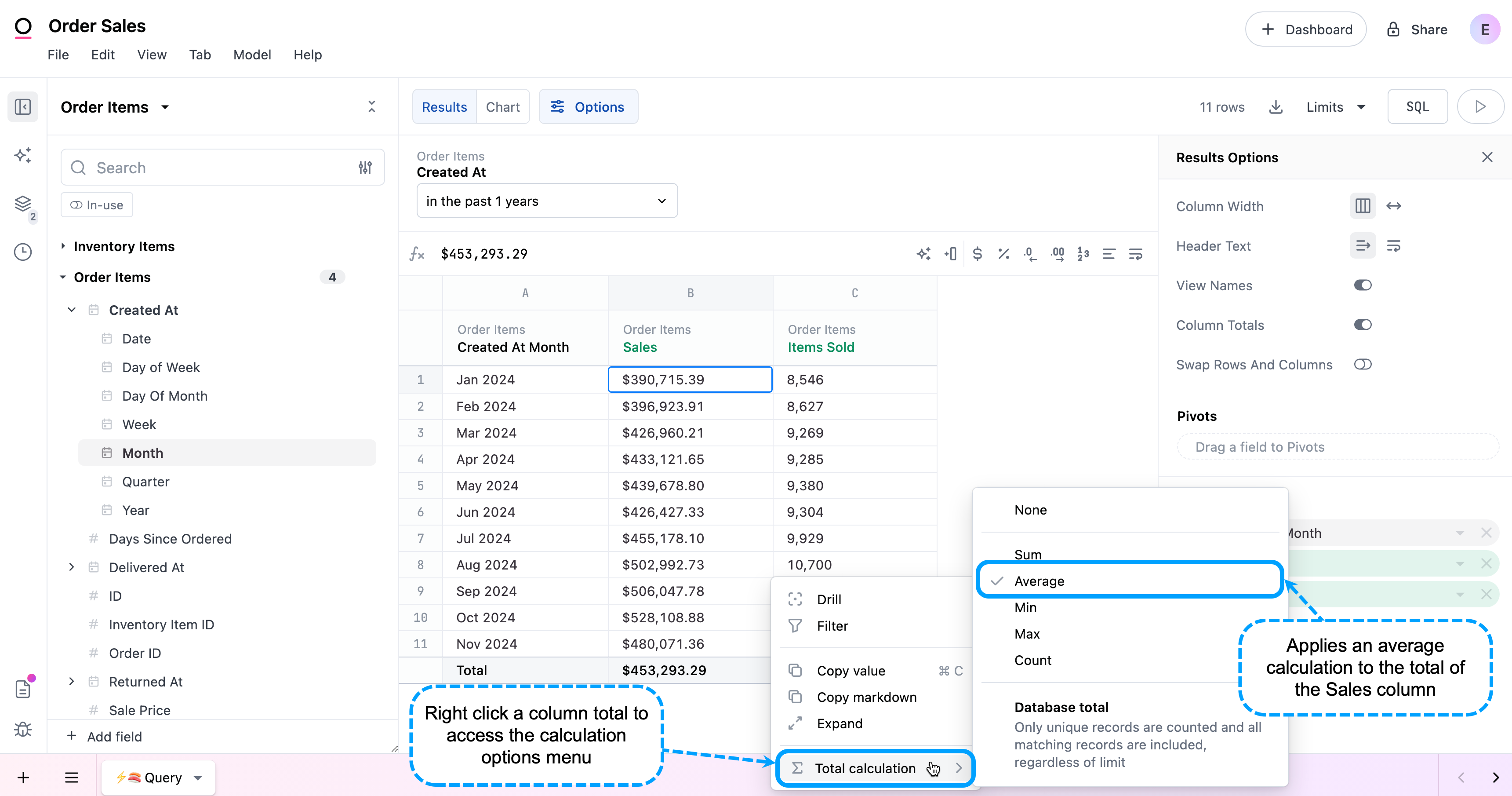
Dimension column totals
By default, dimensions - such as dates or IDs - won’t have a Total value. However, you can still apply one by clicking the column total and using the Total calculation menu.Calculation column totals
Columns with calculations applied can also have custom totals. When column totals are enabled, Omni will default to using the column’s calculation as the initial total. Take the following table as an example, where the AVG Item Price and CONCAT Average Item Text columns use Excel-like formulas:| Date | Order Total | Order Items | AVG Item Price | CONCAT Average Item Text |
|---|---|---|---|---|
| Jan 2024 | $50.00 | 2 | $25.00 | Average item price is $25.00 |
| Feb 2024 | $100.00 | 3 | $33.33 | Average item price is $33.33 |
| Mar 2024 | $72.00 | 6 | $12.00 | Average item price is $12.00 |
| Totals | $222.00 | 11 | $23.44 | Average item price is $23.44 |
- The AVG Item Price column has a formula of
Order Total / Order Items. Using this formula, the column total is$23.44, which is the average of all the values in the column. - The CONCAT Average Item Text column has a formula of
CONCAT("Average item price is ", AVG Item Price). Using this formula, the column total value isAverage item price is $23.44, which uses the column total for the AVG Item Price column.
Row totals
Row totals are only available for queries with at least one pivot.
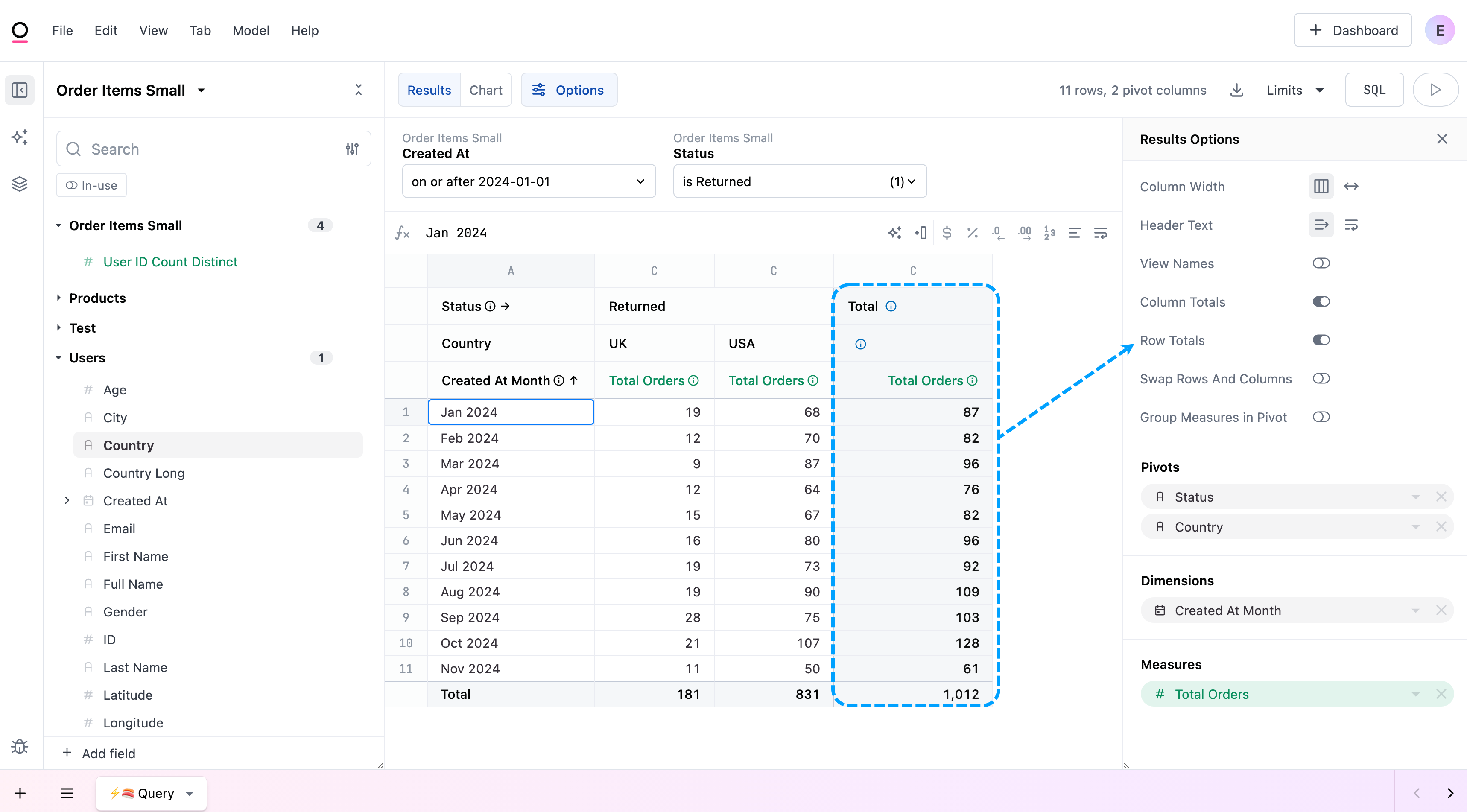
Downloading results
Tab results can be downloaded as a CSV, Excel file, or JSON. Click Tab > Download or the download icon to the left of the Limits menu to get started.Removing fields and filters
Fields can be removed from the table either using the field picker (clicking on active fields will remove them) or right-clicking / kebab-icon-clicking in the column’s table header.All views and fields
Most querying will be done through curated topics in the UI, but at times, admins and developers may need access to the full database for ad hoc requests or in order to build new models. All Views & Fields allows those with access the ability to use the pivottable UI to query any table available for a given connection. The dropdown above the search box offers two options to discover views:- Views from modeled schemas
- Each schema in the database
label: Users); this will be done through a curation process like starring in the future
For now, search will only operate inside the selected schema (or across all modeled schemas), so you may have to switch schemas to find the appropriate table if your full warehouse is not modeled. Note this UI will not override Schema Restriction, if the list of schemas has been curated. In the future, we will offer search over all schemas together in addition to schema by schema.
Example
Example
For a customer with 2 schemas of 10 tables each, any modeling in either schema will pull the full schemas into the “Views from modeled schemas”. All Views & Fields will operate as simply one big list of all your tablesFor a customer with 1000 schemas of 10 tables each, likely only 5-10 schemas may be modeled (at least to start). “Views from modeled schemas” will by default curate the list of tables to those 10 schemas, but to browser alternative schemas, select them from the dropdown.
Period-over-period analysis
Period-over-period (PoP) analysis is a business intelligence technique that compares metrics in a recent period to the same period in the past. You can seamlessly create those time periods from the field picker by selecting ”Period over Period” from the three dot menu of the date dimension you want to use.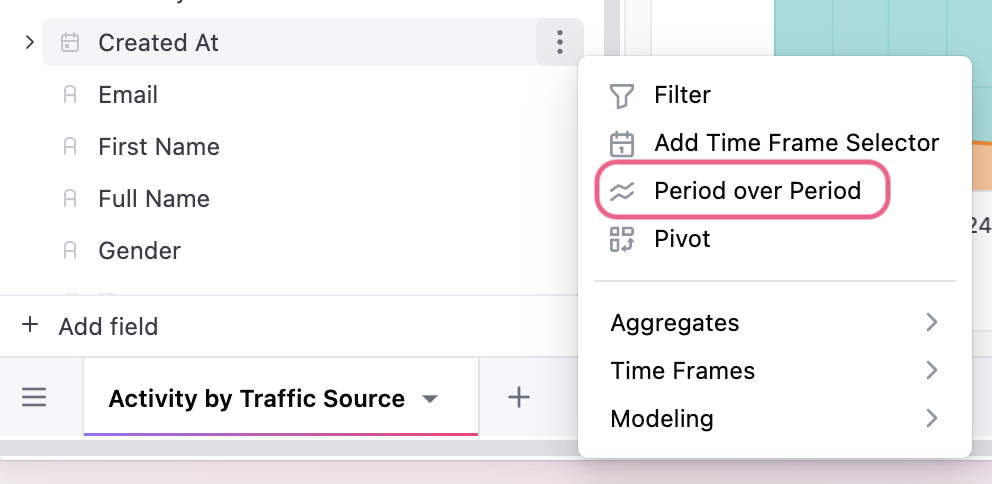

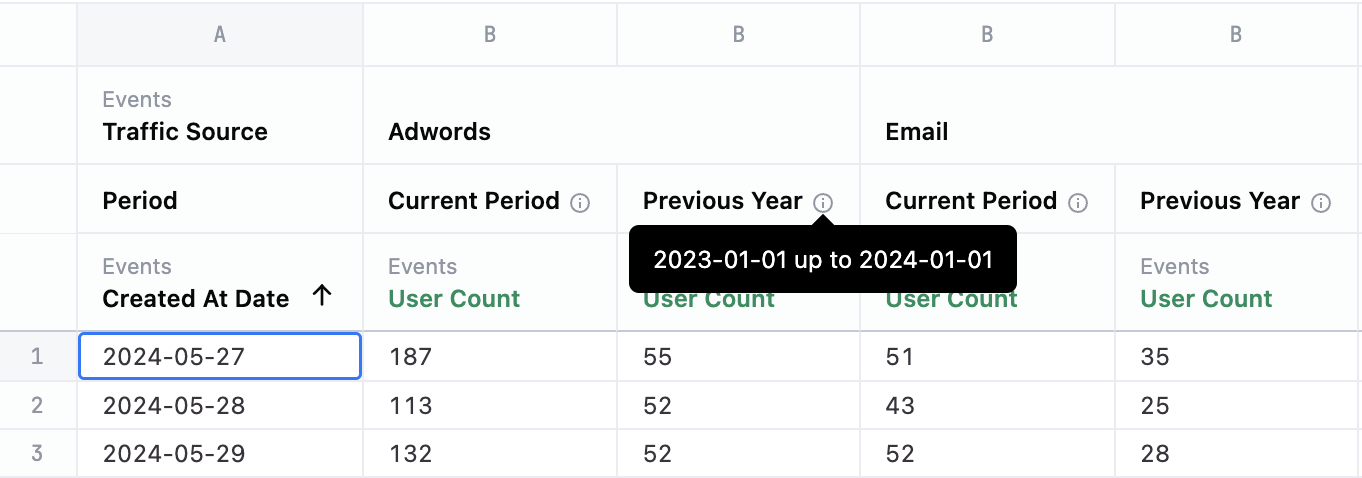
Filling missing data
Dimension filling

Pivoted table filling
In addition to filling dimensions, it’s often valuable to fill a pivoted table that contains nulls for ‘more correct’ reporting of aggregates. To replace nulls with 0s in the pivottable, simply select “Fill in Missing Cells in Grid” on a pivoted report: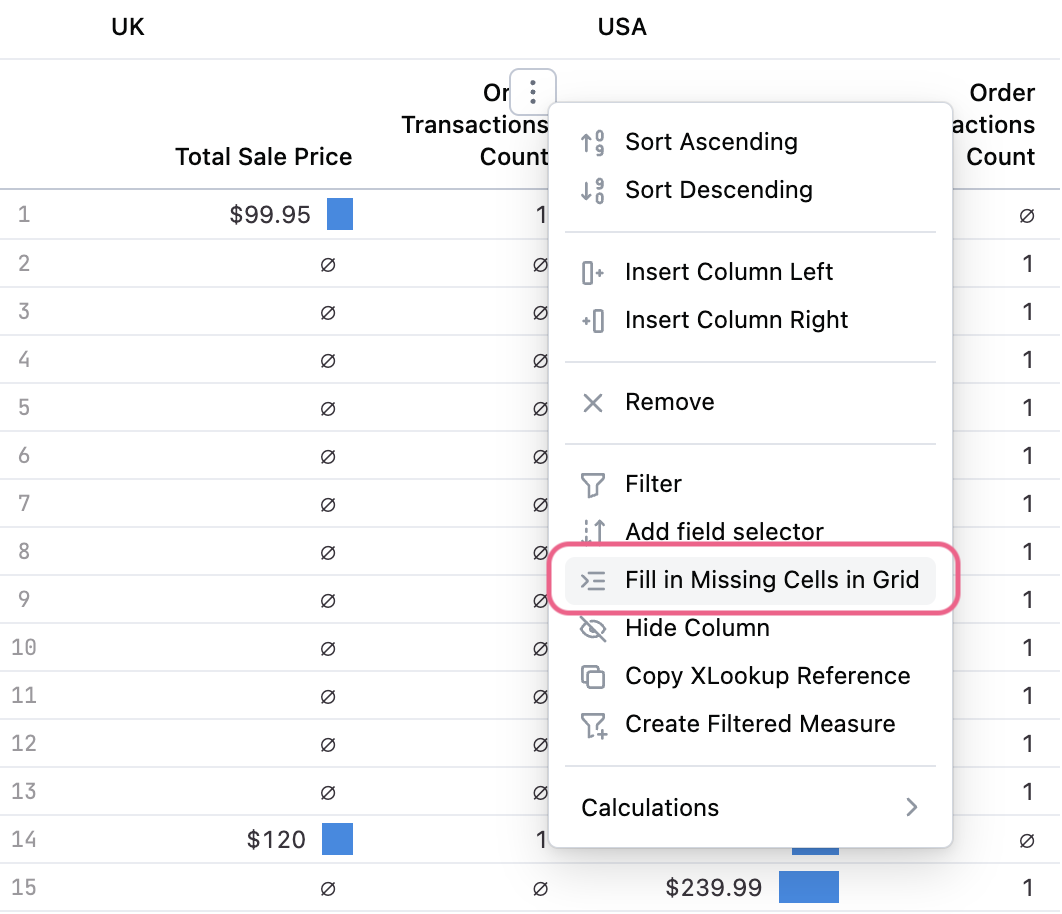
Joining tables
Database uploads must be enabled to join data input or CSV data using the methods described in this section. Otherwise, you can use the
XLOOKUP function to perform cross-tab analysis. Refer to the Data input tables guide for more information and examples.
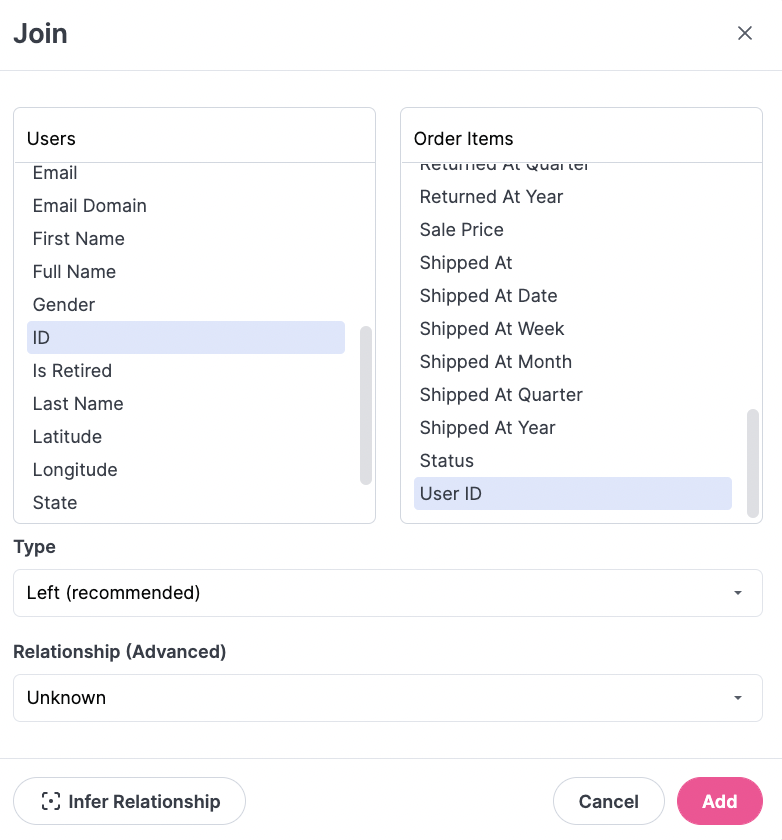
Adding joins to a topic
For existing joins that are not available in a topic, users will be prompted whether they want to add said join to the active topic.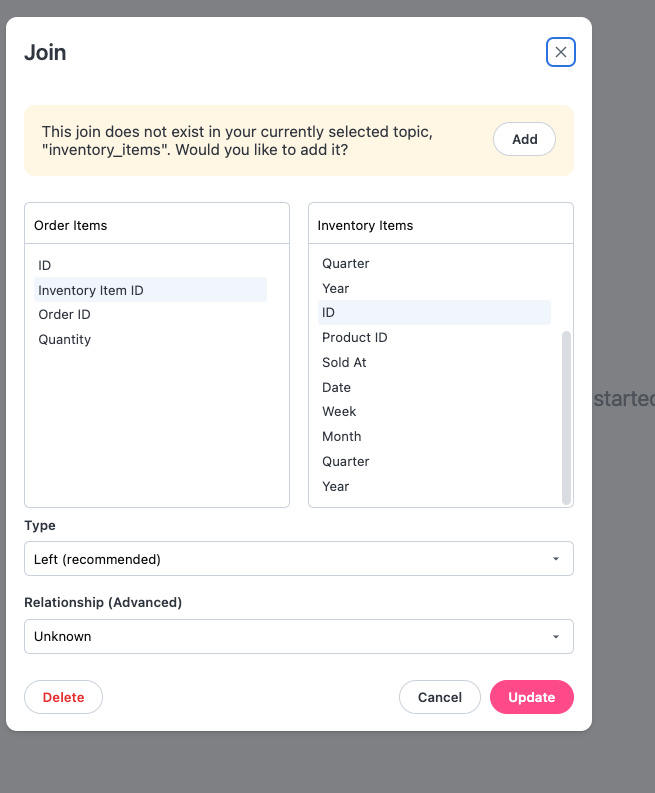
Join table and field selection
Simply select the table and corresponding fields to join. Right now compound joins or complex logic is not available in the UI, and must be configured in the model interface. Clicking in the table dropdown will also present a search option if there are many tables in the data warehouse.Join types
Omni offersLEFT, RIGHT, INNER, FULL OUTER, and CROSS joins in the UI.
Join relationships
Join relationships are used to ensure correctness of counts when joins may fan the result set (ie joining many orders to a query about users and counting users). If you know the relationship between your tables, you can select via dropdown. Options includeMany to one, One to many, One to one, and Many to many. It is generally recommended to use Many to one joins rather than One to many joins.
For users that may struggle with choosing the correct relationship, when relationship is set to Unknown, the Infer Relationship button will become active. This will examine the cardinality between each join key and select the proper relationship. We recommended using the button, as often uniqueness may not match expectation and this can flag potential data issues like duplicated rows or keys.
Adding controls
Controls allow a user to swap out one field for another on a query making it more dynamic. There are three main types of controls:- Time
- Field
- Parent
Time controls
These controls will allow you to swap the time frame within the underlying query. This provides an easy UI based mechanism to swap from daily to weekly to monthly and back again, all without any underlying work needing to be done to facilitate it from an administrative perspective. A time frame control can be added from either the field picker or from the date field in the results table by choosing Add Time Frame Selector from the three dot menu.Field
In order to create a control for dimensions or measures, first add one to the query and switch to the Results view. From there, select the three dot menu on the column and Add field selector. A control will appear above the table with a three dot menu for a user to edit the control (change the label, add additional fields, or add a parent control). Once there are two or more options in the control, a user can select the field they want represented in the table or visualization and dynamically toggle among the options.Parent controls
These controls will allow you to coordinate the toggling of multiple controls at once from a single point and click UI. From any existing control, select the option Add parent control. A control will appear above the table, select the three dot menu to edit the control. First add options that will appear in the drop down, then assign the child controls that will be chosen based on the option selected in the parent control.Controls created in the workbook will not appear on the dashboard. Read more about how to add controls on the dashboard level here.

